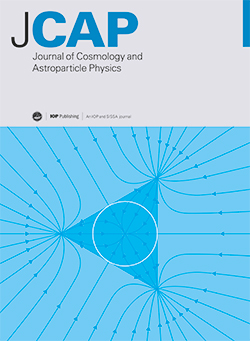来自具有大额外维度的原始黑洞蒸发的引力波
IF 5.3
2区 物理与天体物理
Q1 ASTRONOMY & ASTROPHYSICS
Journal of Cosmology and Astroparticle Physics
Pub Date : 2024-08-22
DOI:10.1088/1475-7516/2024/08/033
引用次数: 0
摘要
黑洞蒸发产生的引力波频谱一般会在霍金温度数量级的频率上达到峰值,这使得这一信号对于在早期宇宙中蒸发的原始黑洞来说具有超高频率。这促使我们考虑具有大额外维度的理论中的小黑洞,由于真正的体普朗克尺度 M* 可能比有效 MPl 小得多,因此峰值频率可以大大降低。我们研究了超轻原始黑洞在大额外维度理论背景下霍金蒸发过程中的星系局域引力子发射,最终目的是计算随机引力波背景的贡献。为了精确地模拟黑洞演化,我们计算了自旋为0、1/2、1和2的粒子在星系上和主体中发射的灰度因子,假定大部分发射是在施瓦兹柴尔德阶段进行的。然后,我们计算了引力波信号中引力子的功率谱和现今谱密度参数。我们发现,在参数的最佳选择下,峰值频率在亚兆赫范围内趋于平稳,在计划中的高频引力波探测器的探测范围内,一旦它们的灵敏度超过ΔNeff 界限,这种情况就会成为探测目标。本文章由计算机程序翻译,如有差异,请以英文原文为准。
Gravitational waves from primordial black hole evaporation with large extra dimensions
The spectra of gravitational waves from black hole evaporation generically peak at frequencies of order the Hawking temperature, making this signal ultra-high frequency for primordial black holes evaporating in the early universe. This motivates us to consider small black holes in theories with large extra dimensions, for which the peak frequency can be lowered substantially, since the true bulk Planck scale M* can be much smaller than the effective MPl. We study the emission of brane-localized gravitons during the Hawking evaporation of ultra-light primordial black holes in the context of theories with large extra dimensions, with the ultimate goal of computing the contribution to the stochastic gravitational wave background. To accurately model black hole evolution, we compute greybody factors for particles of spin-0, 1/2, 1, and 2 emitted on the brane and in the bulk, presuming the majority of emission proceeds during the Schwarzschild phase. We then compute the power spectrum and present day spectral density parameter for brane-localized gravitons contributing to a gravitational wave signal. We find that for an optimal choice of parameters, the peak frequency plateaus in the sub-MHz regime, within range of planned high-frequency gravitational wave detectors, making this scenario a target for detection once their sensitivity exceeds ΔNeff bounds.
求助全文
通过发布文献求助,成功后即可免费获取论文全文。
去求助
来源期刊

Journal of Cosmology and Astroparticle Physics
地学天文-天文与天体物理
CiteScore
10.20
自引率
23.40%
发文量
632
审稿时长
1 months
期刊介绍:
Journal of Cosmology and Astroparticle Physics (JCAP) encompasses theoretical, observational and experimental areas as well as computation and simulation. The journal covers the latest developments in the theory of all fundamental interactions and their cosmological implications (e.g. M-theory and cosmology, brane cosmology). JCAP''s coverage also includes topics such as formation, dynamics and clustering of galaxies, pre-galactic star formation, x-ray astronomy, radio astronomy, gravitational lensing, active galactic nuclei, intergalactic and interstellar matter.
 求助内容:
求助内容: 应助结果提醒方式:
应助结果提醒方式:


